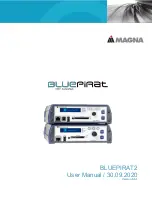
Section 7. Installation
269
The usual method for writing high-frequency time series data to memory cards,
especially in high-speed measurement applications, is to use the
TableFile()
instruction with
Option 64
. It supports 16 GB or smaller memory cards and
permits smaller and variable file sizes.
7.7.10.1 TableFile() with Option 64
Option 64
has been added as a format option for the CRBasic instruction
TableFile()
. It combines the speed and efficiency of the
CardOut()
instruction
with the flexibility of the
TableFile()
instruction. Memory cards
1
up to 16 GB
are supported.
TableFile()
with
Option 64
, TOB3 is now available in CR6
operating systems 25 or greater.
TableFile()
is a CRBasic instruction that creates
a file from a data table in datalogger CPU memory.
Option 64
directs that the
file be written in TOB3 format exclusively to the CRD: drive
2
.
Syntax for the
TableFile()
instruction is as follows:
TableFile
(FileName, Option, MaxFiles, NumRecs/
TimeIntoInterval, Interval, Units, OutStat, LastFileName)
where
Option
is given the argument of
64
. Refer to
CRBasic Editor
Help
3
for a
detailed description of each parameter.
Note
The CRD: drive (the drive designation for the optional memory
card) is the only drive that is allowed for use with
Option 64
.
Note
Memory cards add a measure of security in guarding against data
loss. However, no system is infallible. Finding a functioning memory
card in the mud after a moose has trampled your weather station or a
tractor has run an offset disk over your soil-moisture station may be
difficult. The best rule is to collect data from the CR6 only as often as you
can afford to lose the data. In other words, if you can afford to lose a
months worth of data, you can afford to collect the data only once a
month.
1
Memory cards for the CR6 are the micro SD type.
2
The CRD: drive is a memory drive created when a memory card is inserted into the CR6.
3
CRBasic Editor
is included in Campbell Scientific
datalogger support software
(p. 97)
suites
LoggerNet
,
PC400
, and
RTDAQ
.
7.7.10.2 TableFile() with Option 64 Replaces CardOut()
TableFile()
with
Option 64
has several advantages over
CardOut()
when used in
most applications. These include:
•
Allowing multiple small files to be written from the same data table so
that storage for a single table can exceed 2 GB.
TableFile()
controls the
size of its output files through the
NumRecs
,
TimeIntoInterval
, and
Interval
parameters.
•
Faster compile times when small file sizes are specified.
Summary of Contents for CR6 Series
Page 2: ......
Page 4: ......
Page 6: ......
Page 32: ......
Page 36: ......
Page 38: ......
Page 76: ...Section 5 Overview 76 FIGURE 20 Half Bridge Wiring Example Wind Vane Potentiometer ...
Page 80: ...Section 5 Overview 80 FIGURE 23 Pulse Input Wiring Example Anemometer ...
Page 136: ......
Page 454: ...Section 8 Operation 454 FIGURE 104 Narrow Sweep High Noise ...
Page 459: ...Section 8 Operation 459 FIGURE 106 Vibrating Wire Sensor Calibration Report ...
Page 535: ...Section 8 Operation 535 8 11 2 Data Display FIGURE 121 CR1000KD Displaying Data ...
Page 537: ...Section 8 Operation 537 FIGURE 123 CR1000KD Real Time Custom ...
Page 538: ...Section 8 Operation 538 8 11 2 3 Final Storage Data FIGURE 124 CR1000KD Final Storage Data ...
Page 539: ...Section 8 Operation 539 8 11 3 Run Stop Program FIGURE 125 CR1000KD Run Stop Program ...
Page 541: ...Section 8 Operation 541 FIGURE 127 CR1000KD File Edit ...
Page 546: ......
Page 552: ......
Page 610: ...Section 11 Glossary 610 FIGURE 137 Relationships of Accuracy Precision and Resolution ...
Page 612: ......
Page 648: ......
Page 650: ......
Page 688: ......
Page 689: ......
















































